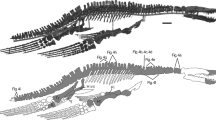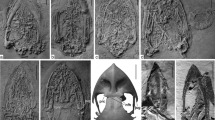Abstract
The Ramapithecinae are an extinct, mainly Miocene group of hominoids, whose relationship to modern taxa is disputed. Some regard them as hominids, while others view them as ancestral toPongo,or even as the group ancestral to both hominids and extant apes. In this paper a systematic revision of Ramapithecinae is undertaken. Sivapithecus sivalensis andRamapithecus punjabicus are considered the same species, with the former name having priority. A new Indian species,Sivapithecus simonsi,is recognized. Ramapithecine anatomy is reviewed and compared with that of gracileAustralopithecus, early and middle MioceneProconsul andDryopithecus, and living pongidsPan, Gorilla, andPongo.Ramapithecines are shown to be much more primitive or “ape-like” than some have argued. Anatomical data are evaluated cladistically with several results. Parallel evolution in the jaws, teeth, and facial structure of hominoids appears to be the rule rather than the exception. Bearing this in mind, nevertheless, from the available evidence of anatomy, ramapithecines are cladistically hominids.
Similar content being viewed by others
References
Andrews, P. J. (1978). A revision of the Miocene Hominoidea of East Africa.Bull. Br. Mus. Nat. Hist. (Geol.) 30: 85–224.
Andrews, P. J., and Molleson, T. (1979). The provenance ofSivapithecus africanus.Bull. Br. Mus. Nat. Hist. (Geol.) 32: 19–23.
Andrews, P., and Tekkaya, I. (1980). A revision of the Turkish Miocene hominoidSivapithecus meteai.Paleontology 23: 85–95.
Andrews, P., and Tobien, H. (1977). New Miocene locality in Turkey with evidence on the origin ofRamapithecus andSivapithecus.Nature 268: 699–701.
Coolidge, H. J., Jr. (1933).Pan paniscus. Pigmy chimpanzee from south of the Congo River.Am. J. Phys. Anthropol. 18: 1–57.
de Bonis, L., and Melentis, J. (1977). Les Primates hominoÏdes du Vallésien de Macédoine (Grèce). étude de la mâchoire inférieure.Geobios 10: 849–885.
de Bonis, L., and Melentis, J. (1978). Les Primates hominoÏdes du Miocène Supérieur de Macédoine. étude de la mâchoire supérieure.Ann. Paléontol. 64: 185–202.
de Bonis, L., and Melentis, J. (1980). Nouvelles remarques sur l’anatomie d’un Primate hominoÏde du Miocène:Ouranopithecus macedoniensis. Implications sur la phylogénie des Hominidés.C.R. Acad. Sci. Paris 290: 755–758.
de Bonis, L., Bouvrain, G., Geraads, D., and Melentis, J. (1974). Première découverte des Primates hominoÏde dans le Miocène supérieur de Macédoine (Grèce).C.R. Acad. Sci. Paris 278: 3063–3066.
Delson, E. (1977). Catarrhine phylogeny and classification: Principles, methods and comments.J. Hum. Evol. 6: 433–459.
Delson, E., and Andrews, P. (1975). Evolution and interrelationships of the catarrhine primates. In Luckett, W. P., and Szalay, F. S. (eds.),Phylogeny of the Primates, Plenum Press, New York, pp. 405–446.
Eaglen.R. H. (1980).The Systematics of Living Strepsirhini with Special Reference to the Lemuridae, Ph.D. thesis, Duke University, Durham, N.C.
Farris, J. S. (1970). Methods for computing Wagner trees.Syst. Zool. 19: 83–92.
Gantt, D. G. (1977).Enamel of Primate Teeth, Ph.D. thesis, Washington University, St. Louis.
Gingerich, P. D. (1974). Size variability in living mammals and the diagnosis of closely related sympatric fossil species.J. Paleontol. 48: 895–903.
Gingerich, P. D., and Schoeninger, M. (1979). Patterns of tooth size variability in the dentitions of primates.Am. J. Phys. Anthropol. 51: 457–466.
Greenfield, L. O. (1977).Ramapithecus and Early Hominid Origins, Ph.D. thesis, University of Michigan, Ann Arbor.
Greenfield, L. O. (1979). On the adaptive pattern ofRamapithecus.Am. J. Phys. Anthropol. 50: 527–548.
Greenfield, L. O. (1980). A late divergence hypothesis.Am. J. Phys. Anthropol. 52: 351–365.
Gregory, W. K., Hellman, M., and Lewis, G. E. (1938). Fossil Anthropoids of the Yale-Cambridge India Expedition of 1935. Carnegie Institution of Washington Publication No. 495.
Hooijer, D. A. (1948). Prehistoric teeth of man and of the orangutan from central Sumatra, with notes on the fossil orangutans from Java and Southern China.Zool. Med. 29: 175–284.
Johanson, D. C. (1974). Some metric aspects of the permanent and deciduous dentition of the pygmy chimpanzee (Pan paniscus).Am. J. Phys. Anthropol. 41: 39–48.
Johanson, D. C., and White, T. D. (1979). A systematic assessment of early African hominids.Science 202: 321–330.
Kay, R. F. (1981). The nut-crackers-a new theory of the adaptations of the Ramapithecinae.Am. J. Phys. Anthropol. 55: 141–152.
Kay, R. F. (1982). Sexual dimorphism in Ramapithecinae.Proc. Natl. Acad. Sci. USA 79: 209–212.
Kay, R. F., and Simons, E. L. (1982). A reassessment of the relationship between later Miocene and subsequent Hominoidea. In Ciochon, R. L., and Corruccini, R. F. (eds.),New Interpretations of Ape and Human Ancestry, Plenum Press, New York (in press).
Kretzoi, M. (1975). New ramapithecines andPliopithecus from the lower Pliocene of Rudabánya in north-eastern Hungary.Nature 257: 578–581.
Leakey, L. (1962). A new lower Pliocene fossil from Kenya.Ann. Mag. Nat. Hist. 13: 689–696.
Le Gros Clark, W. E. (1952). Hominid characters of the australopithecine dentition.J. Roy. Anthropol. Inst. 80 (1950): 37–54.
Le Gros Clark, W. E., and Leakey, L. (1950). Diagnosis of East African Miocene Hominoidea.Q. J. Geol. Soc. London 105: 260–262.
Le Gros Clark, W. E., and Leakey, L. (1951). The Miocene Hominoidea of East Africa.Fossil Mammals Afr. 1: 1–117.
Mahler, P. E. (1973).Metric Variation in the Pongid Dentition, Ph.D. thesis, University of Michigan, Ann Arbor.
Mayr, E. (1969).Principles of Systematic Zoology, McGraw-Hill, New York, pp. 1–428.
McHenry, H. M., Andrews, P., and Corruccini, R. S. (1980). Miocene hominoid palatofacial morphology.Folia primatol. 33: 241–252.
Moorrees, C. F. A. (1957).The Aleut Dentition, Harvard University Press, Cambridge, Mass., pp. 1–196.
Mottl, M. von (1957). Bericht über die neuen Menschenaffenfunde aus österreich, von St. Stefan im Lavanttal, KÄrnten.Naturwiss. Beit. Heimat. Kaern. 67: 39–84.
Ozansoy, F. (1957). Faunes des mammifères du Tartiare de Turquie et leurs révisions stratigraphique.Bull. Miner. Res. Explor. Inst., Ankara, 49: 29–48.
Ozansoy, F. (1965). étude des gisements continentaux et des mammiféres du CénozoÏque de Turquie.Mém. Soc. Geol. France, 44: 5–89.
Pandey, J., and Sastri, V. V. (1968). On a new species ofSivapithecus from the Siwalik rocks of India.J. Geol. Soc. India 9: 207–211.
Pilbeam, D. R. (1969). Tertiary Pongidae of East Africa.Bull. Peabody Mus. 31: 1–185.
Pilbeam, D. (1979). Recent finds and interpretations of Miocene hominoids.Annu. Rev. Anthropol. 8: 333–352.
Pilbeam, D. R., and Zwell, M. (1972). The single species hypothesis, sexual dimorphism, and variability in early hominids.Yearb. Phys. Anthropol. 16: 69–79.
Pilbeam, D. R., Berry, J., Meyer, G. E., Shah, S. M. I., Pickford, M. H. L., Bishop, W. W., Thomas, H., and Jacobs, L. L. (1977a). Geology and paleontology of Neogene strata of Pakistan.Nature 270: 684–689.
Pilbeam, D., Meyer, G. E., Badgley, C., Rose, M. D., Pickford, M. H. L., Behrensmeyer, A. K., and Shah, S. M. I. (1977b). New hominoid primates and their bearing on hominoid evolution.Nature 270: 689–695.
Pilbeam, D. R., Behrensmeyer, A. K., Barry, J. C., and Shah, S. M. I. (1979). Miocene sediments and faunas of Pakistan.Postilla Peabody Mus. 179: 1–45.
Pilbeam, D. R., Rose, M. D., Badgley, C., and Lipschutz, B. (1980). Miocene hominoids from Pakistan.Postilla Peabody Mus. 181.
Pilgrim, G. E. (1910). Notice of new mammalian genera and species from the Tertiary of India.Rec. Geol. Surv. India 50: 63–71.
Pilgrim, G. E. (1915). New Siwalik primates and their bearing on the question of the evolution of man and the Anthropoidea.Geol. Surv. India 45: 1–74.
Remane, A. (1960). ZÄhne und Gebiss.Primatologia 3: 637–846.
Robinson, J. T. (1956). The genera and species of the Australopithecinae.Am. J. Phys. Anthropol. 12: 181–200.
Simons, E. L. (1976). The nature of the transition in the dental mechanism from pongids to hominids.J. Hum. Evol. 5: 511–528.
Simons, E. L. (1981). Man’s immediate forerunners.Phil. Trans. Roy. Soc. London B292: 21–41.
Simons, E. L., and Chopra, S. R. K. (1969).Gigantopithecus (Pongidae, Hominoidea) A new species from Northern India.Postilla Peabody Mus. 138: 1–18.
Simons, E. L., and Pilbeam, D. R. (1965). Preliminary revision of the Dryopithecinae (Pongidae, Anthropoidea).Folia Primatol. 3: 81–152.
Swindler, D. P. (1976).Dentition of Living Primates, Academic Press, New York.
Szalay, F. S., and Delson, E. (1979).Evolutionary History of the Primates, Academic Press, New York.
Tekkaya, I. (1974). A new species of Tortonian anthropoid (Primates, Mammalia) from Anatolia.Bull. Min. Res. Explor. Inst. Turkey 83: 148–165.
Thorington, R. W., and Groves, C. P. (1970). An annotated classification of the Cercopithecoidea. In Napier, J. R., and Napier, P. H. (eds).,Old World Monkeys, Academic Press, New York, pp. 629–648.
Verheyen, W. N. (1962). Contribution à la craniologie comparée des Primates.Mus. Roy. Afr. Centrale Tervuren Belg., Sér. 8 Sci. Zool. 105: 1–255.
White, T. D. (1977). New fossil hominids from Laetoli, Tanzania.Am. J. Phys. Anthropol. 46: 197–230.
White, T. D. (1980). Additional fossil hominids from Laetoli, Tanzania: 1976–1979 specimens.Am. J. Phys. Anthropol. 53: 487–504.
Whybrow, P. J., and Andrews, P. (1978). Restoration of the holotype ofProconsul nyanzae.Folia Primatol. 30: 115–125.
Wolpoff, M. H. (1980).Paleoanthropology, A. H. Knopf, New York.
Woo, J.-K. (1958). New materials ofDryopithecus from Keiyuan, Yunnan.Vert. Palas. 2: 38–43.
Xu, Q., and Lu, Q. (1979). The mandibles ofRamapithecus andSivapithecus from Lufeng, Yunan.Vert. Palas. 17: 1–13.
Xu, Q., and Lu, Q. (1980). The Lufeng ape skull and its significance.China Reconstructs 29: 56–57.
Xu, Q., Lu, Q., Pan, J., Chi, K., Zhang, C., and Zheng, L. (1978). On the fossil mandible ofRamapithecus lufengensis.Kexue Tongbao 23: 554–556.
Zihlman, A. L., Cronin, J. E., Cramer, D. L., and Sarich, V. M. (1978). Pygmy chimpanzee as a possible prototype for the common ancestor of humans, chimpanzees, and gorillas.Nature 275: 744–746.
Author information
Authors and Affiliations
Rights and permissions
About this article
Cite this article
Kay, R.F. Sivapithecus simonsi, a new species of miocene hominoid, with comments on the phylogenetic status of the ramapithecinae. Int J Primatol 3, 113–173 (1982). https://doi.org/10.1007/BF02693493
Received:
Revised:
Accepted:
Issue Date:
DOI: https://doi.org/10.1007/BF02693493




